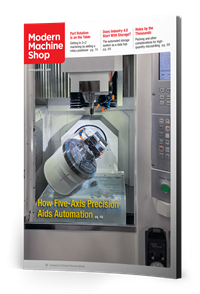Share







The Taipei International Machine Tool Show (TIMTOS) 2025 took place March 3-8 at Taipei Nangang Exhibition Center Halls 1 and 2, as well as Taipei World Trade Center Hall 1. The show featured more than 1,000 exhibitors from Taiwan and around the world. Photos provided by MMS.
Doing business in the global economy has become difficult thanks to recent and ongoing factors such as the COVID-19 pandemic, geopolitical instability and economic volatility. But, according to many exhibitors at the 2025 Taipei International Machine Tool Show (TIMTOS), technology is helping manufacturers and their suppliers stay competitive, even in difficult conditions. At the show’s opening ceremony on March 3, David Chuang, chairman of the Taiwan Association of Machinery Industry (TAMI), noted that despite the complex economic conditions, Taiwan’s thriving machine tool industry is working to serve the global market.
Digital Technologies
AI, AR/VR and digital twins were all prominent across the show floor. Digital technology is advancing and finding its place in the manufacturing industry, ultimately providing benefits in the physical world from shorter cycle times and reduced downtime to improved part quality and lower energy consumption.

ITRI is a Taiwanese research organization that supports industrial development in Taiwan, including through the advancement of digital twin technologies. This demonstration shows how digital twins can be used for diagnosing and fixing machine tools with the help of VR.
The Industrial Technology Research Institute (ITRI), which supports industrial development in Taiwan, showcased several uses for digital twins. The institute uses Siemens’ digital twin technology as a base for a digital twin of a machine tool, then adds other information such as dynamics and stiffness to the model using data collected from sensors on the physical machine tool. Senior Business Manager Shuo-Peng Liang says that digital twins of the machine’s control can be used to improve cycle times on part programs, while digital twins of the machine tool can improve part quality. Digital twins of a machine can then be incorporated into a digital twin of a machining cell, which can then be used to build a digital twin of a production line and ultimately, a digital twin of the entire factory. These digital twins can be used for remote diagnostics and support, further aided by AR or VR, Liang says. For example, a manufacturer can give a technician the standard operating procedures and then use AR or VR to help diagnose and fix an issue with a machine. “Only discussion won’t solve a problem,” Liang notes.
Meanwhile, Andy Chu, vice president at Supertec Machinery, said that the company and its Taiwanese parent company, E-Tech Machinery, were mostly using digital twins in quoting as opposed to service and training. Chu said digital twins are useful for building cells with automation (particularly in situations with space constraints) and performing virtual runs.

With FATEK’s digital parts and equipment manuals, machine alarms have QR codes that users can scan (as seen here). This brings up information from the equipment manual, aided by augmented reality to help users resolve the alarm. It also automatically pulls up a digital parts manual where users can order any required parts online.
Factory Automation Technology (FATEK), a member of the Far East Machinery Company (FEMCO) Group, demonstrated its digital parts and equipment manuals. This is a new feature where machine alarms are accompanied by QR codes that, when scanned, bring up information from the equipment manual to help resolve the issue. AR then helps walk users through the resolution process, and they can order any necessary components online in the same environment.

YCM’s iCube interactive control enables users to control a machine with their voice via an HMI for FANUC controls. While its applicability might be limited in a production environment, it shows how digital technology can increase productivity.
YCM’s booth boasted 32 scenarios for AI and machining and a demonstration of its iCube interactive control, which enables users to control a machine with their voice via an HMI for FANUC controls. YCM’s general manager, Patrick Chen, noted that this demonstration is mostly for marketing purposes (an actual voice-activated machine control would pose many safety concerns in a working manufacturing environment). However, it demonstrated how technology can help novice machine operators learn and make experienced machinists even more productive. He also showed a 360-degree camera powered by Cupola360, which was providing real-time monitoring in the assembly area at YCM’s factory. This provides not only safety, but also traceability and can even become a source of data that can be analyzed to find efficiencies.
At the TIMTOS Keynote x Forum on March 4, Techman Robot CEO Haw Chen presented on AI-enhanced automation. The company’s TM AI cobots have an integrated vision system and native AI engine that can help with part positioning, measurement, part identification (via QR or bar codes) and visual inspection, minimizing the need for manual labor. He cited one example of an automotive manufacturer that used four Techman cobots and 30 cameras to inspect 120 elements of a vehicle in 80 seconds.
Later that day, Christine Herbst-Kubitz, GM of Siemens Digital Industries Taiwan, spoke about how digital technologies such as AI and digital twins will change manufacturing with regards to sustainability. Adaptive control and monitoring (ACM) uses machine learning to adjust cutting conditions during machining for optimized spindle load, increased productivity and reduced energy consumption. Simulating processes using digital twins results in fewer prototypes and therefore less material, time and cost. In production, digital twins can also be used for training and data generation with lower energy consumption.
Custom Solutions
When economic and trade conditions are difficult, global companies have an even harder time competing in the market for ready-made machine tools. Suppliers can have more success by offering custom machine tools and turnkey systems such as automated cells and production lines. Many Taiwanese suppliers at the show were featuring machines that can be customized with different capabilities and integrated automation.

This 3D-printed model represents the workpiece Tongtai was showing in its TMS-I880S multitasking turning center. The part’s complex features require turning, milling and gearmaking capabilities.
Tongtai, part of TT Group, is known for its range of machine tools from five-axis machines to multi-tasking turning centers, such as the TMS-I880S. The sample workpiece in the machine showcased its turning, milling and gearmaking capabilities. The company also provides custom automation from single-machine solutions to fully automated production lines. Arthur Deng, a project manager in the sales and service operations department at Tongtai, walked me through an interactive representation of the company’s Automation Classification Standards, showing different areas and levels of automation, which the company uses to design hardware and software automation systems that are tailored to the user.

Palmary’s new PCB-3015-3 CNC centerless grinder was equipped with an automated measurement system that used a Mitutoyo laser system to sort good parts from bad based on set tolerance limits.
Palmary produces an extensive variety of grinding machines from surface grinders to centerless, vertical, cylindrical and custom models. The company was demonstrating its new PCB-3015-3 CNC centerless grinder, which has an optional four-axis robot for loading and unloading, and an optional automated measuring system. A Mitutoyo laser measuring system measures the parts (in the case of the demo, pins for the automotive industry) as they move down a conveyor belt, and parts that are outside of the set tolerance band are separated from the good parts.

This automated cell from Leantec shows a robot moving parts from a CNC machine to a CMM to a laser marking system. This was the final cell in a demo production line of multiple cells tied together by Syntec’s Synfactory software.
Leantec is a subsidiary of machine control maker Syntec that focuses on automation. Its booth featured multiple automation cells that represented a production line on a shop floor. The final automation cell in the production line showcased a robot that tended a CNC machine, then moved finished parts to a CMM for measurement and finally to a laser marking machine. The components of the cell and the cells in the production line were all tied together by Syntec’s Synfactory software, which has the capability to monitor multiple factories at once for performance, energy usage and more.

The YV 1600ATC+C on display in You Ji’s booth represented one of many different machine configurations available in the company’s YV series of vertical turning lathes. The machines can have chucks ranging from 8 inches to 40 inches; automatic toolchangers or gang-type tooling; twin spindles; and milling, drilling and grinding capabilities.
You Ji is another Taiwanese machine tool supplier that, according to overseas sales department deputy section manager Jerry Wu, can design custom and turnkey solutions including machines, tooling and processes based on the part the customer is producing. Its YV series of vertical turning lathes is available with chucks from as small as 8 inches to as large as 40 inches. Tooling options range from time-saving automatic toolchangers to cost-saving gang-type tooling. Other options include twin spindles and milling, drilling and grinding capabilities. You Ji is also expanding its portfolio to include vertical grinding with the VHG800ATC, which premiered at the show. Wu says it will enable aerospace customers to grind bearings.
Between machines that can be tailored as needs and markets change and software that increases throughput and quality while reducing planning, training, downtime and cost, new technologies will help the Taiwanese machine tool industry respond more quickly to changes as they arise.
Read Next
Data Fuels Robotics Research
At Mill 19, the site of the Advanced Robotics for Manufacturing Institute and Carnegie Mellon University’s Manufacturing Futures Institute, robotics data provides the foundation for AI and digital twins.
Read MoreGenerating a Digital Twin in the CNC
New control technology captures critical data about a machining process and uses it to create a 3D graphical representation of the finished workpiece. This new type of digital twin helps relate machining results to machine performance, leading to better decisions on the shop floor.
Read MoreAI, Data and the Digital Manufacturing Future
AI has the potential to reshape manufacturing software — but first, it will require data.
Read More


















